Note: This website was automatically translated, so some terms or nuances may not be completely accurate.
Unraveling Chinese Tourists in Japan Through Data from China's Largest Lifestyle SNS
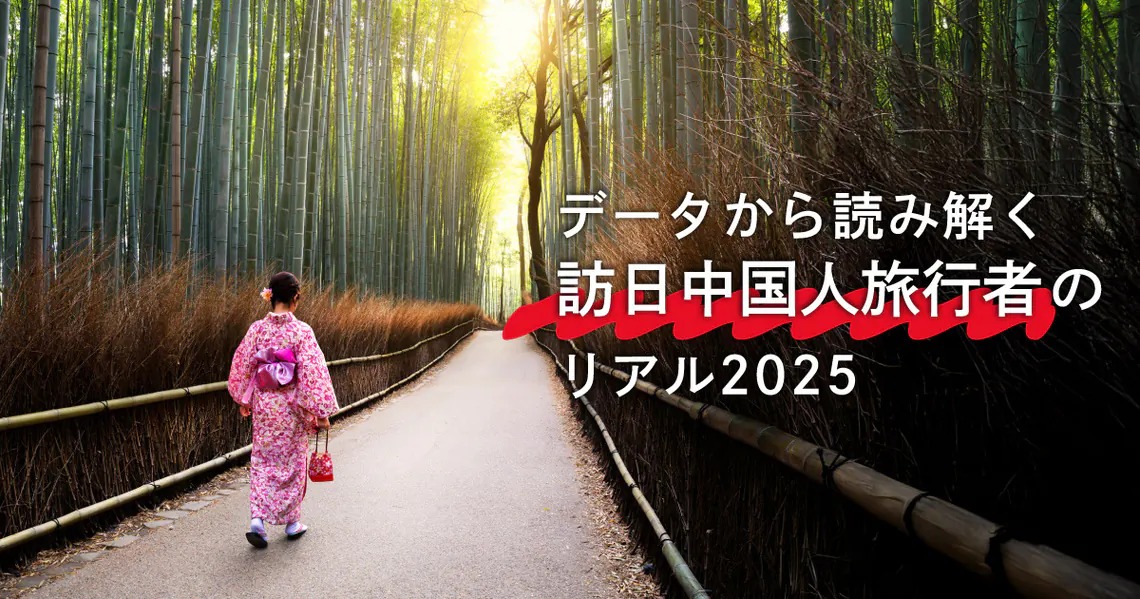
According to Japan National Tourism Organization (JNTO) data, approximately 3.38 million international visitors traveled to Japan in June 2025. The summer vacation season, in particular, consistently sees the highest number of overseas travelers each year, and you likely encountered them frequently within your own communities.This year, the number is expected to increase further due to the Osaka-Kansai Expo. Among these visitors, tourists from China, accounting for nearly a quarter of the total, have always been a key target for inbound marketing, not only due to their scale but also their spending power.
However, following the disruption caused by the COVID-19 pandemic, the situation in China has changed. Research from Dentsu Inc. Global Business Center indicates that the boundaries between the blurring of boundaries between pre-trip, during-trip, and post-trip ." Consequently, destinations, activities, and desired experiences are now significantly "diversifying, becoming more complex, and requiring greater flexibility."
One change emerging from this survey is the growing presence of the app "rednote" (Chinese name: Xiaohongshu), previously less visible in Japan.In interviews with Chinese visitors to Japan, they consistently mentioned "using rednote throughout the entire journey—before, during, and after." Consequently, in collaboration with rednote's operating company, Dentsu Inc. and rednote's operating company pooled their insights and data to explore approaches for engaging Chinese travelers visiting Japan.
■What is rednote?
rednote is China's largest lifestyle app with over 300 million MAU (Monthly Active Users). Its key features include a UI format centered around photos and videos with accompanying text, similar to Instagram or Pinterest, and a recommendation system based on an extremely powerful algorithm, akin to TikTok. It has become indispensable, especially among trend-sensitive young Chinese, not only for overseas travel but also for fashion, hot spots, gourmet dining, and more.
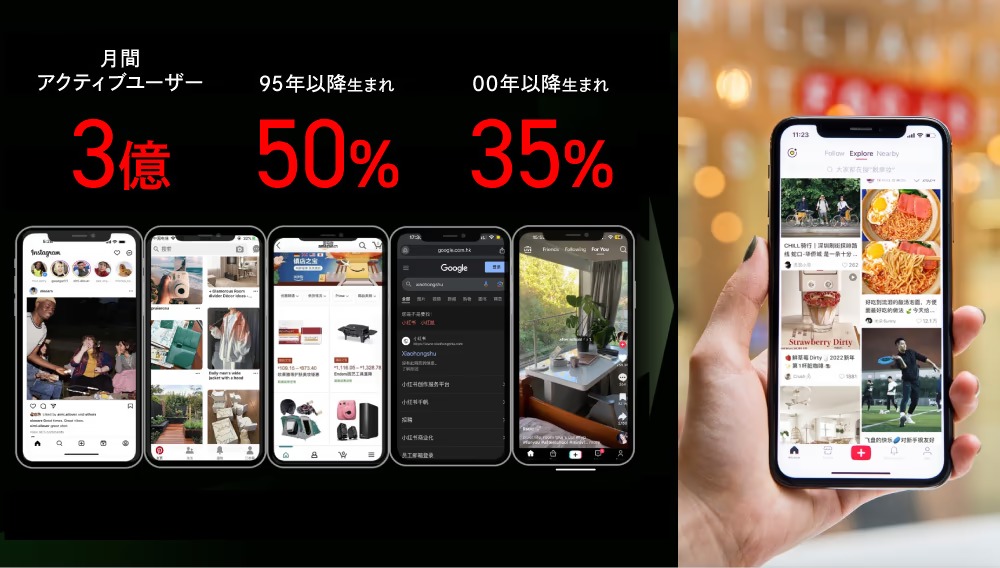
Big Data Reveals the Reality of Visitors to Japan
The big data obtained this time covers the search and browsing behavior of users who visited Japan in 2024. Unlike interviews, big data is an accumulation of "actual actions," revealing even subtle behaviors and true feelings that might not be expressed verbally.
First, let's examine the differences between the overall rednote user base and the segment of users who traveled to Japan. Demographically, rednote is a platform with a high proportion of female users. Within the Japan traveler segment, the female ratio is even higher (considering that among all Chinese visitors to Japan, the ratio is 44.6% male and 55.4% female (※1), the female ratio here is remarkably high).Even within the generally young rednote user base, Japan travelers are younger, with those in their 20s making up the majority. They also tend to come from first-tier cities like Beijing and Shanghai (※2), followed by emerging first-tier cities such as Chengdu (Sichuan Province), Hangzhou (Zhejiang Province), and Wuhan (Hubei Province).
※1 Source: Immigration Control Statistics Table 2023 Annual Report (Ministry of Justice), Residence Status: Short-term Stay (15 days or less + 90 days or less), Nationality/Region: China
※2 China's City Classification:
China categorizes cities into six tiers—Tier 1 (Beijing, Shanghai, etc.), New Tier 1 (Qingdao, Chengdu, etc.), down to Tier 5—based on population, economic level, and other factors. While this is a customary classification rather than a formal administrative division defined by law, it is generally based on the "City Attractiveness Ranking" published by China's major economic magazine "First Financial Daily" and its affiliated think tank. The specific cities included in the ranking change slightly each year.
Reference site: China Media Group "First Financial Releases '2025 New First-Tier Cities Attractiveness Ranking', Refreshing the Past and Rediscovering"
https://www.smg.cn/review/202505/0166469.html
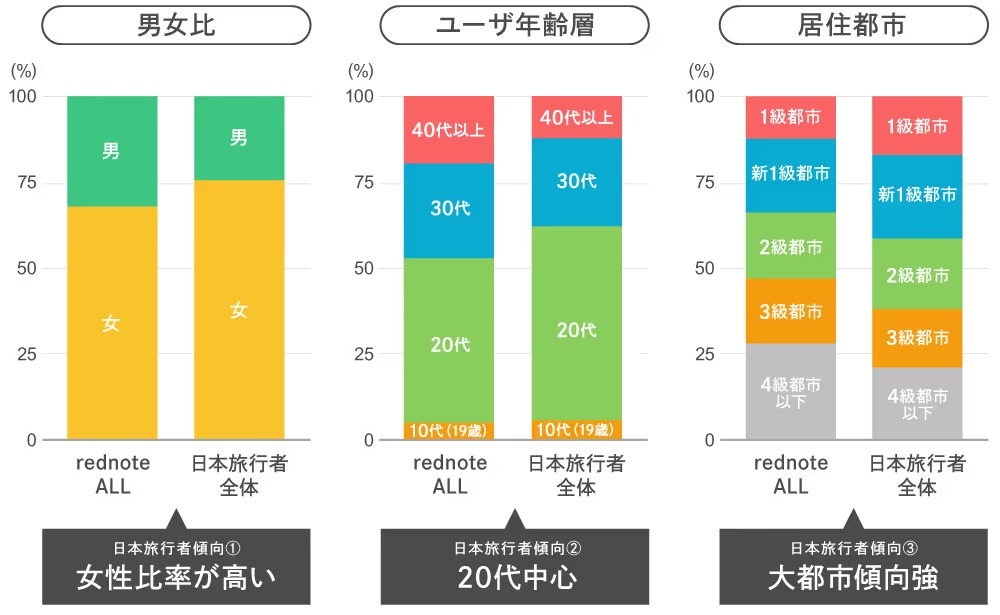
Shifts in Traveler Mindset: Before, During, and After Trips, Seen Through Search Terms
So, what exactly are they doing in Japan? What does this diversification and complexity specifically entail? To explore the overall changes occurring recently, let's examine the trends in the Top 10 search keywords during the Spring Festival period over the last three years, broken down into "Before Travel," "During Travel," and "After Travel."
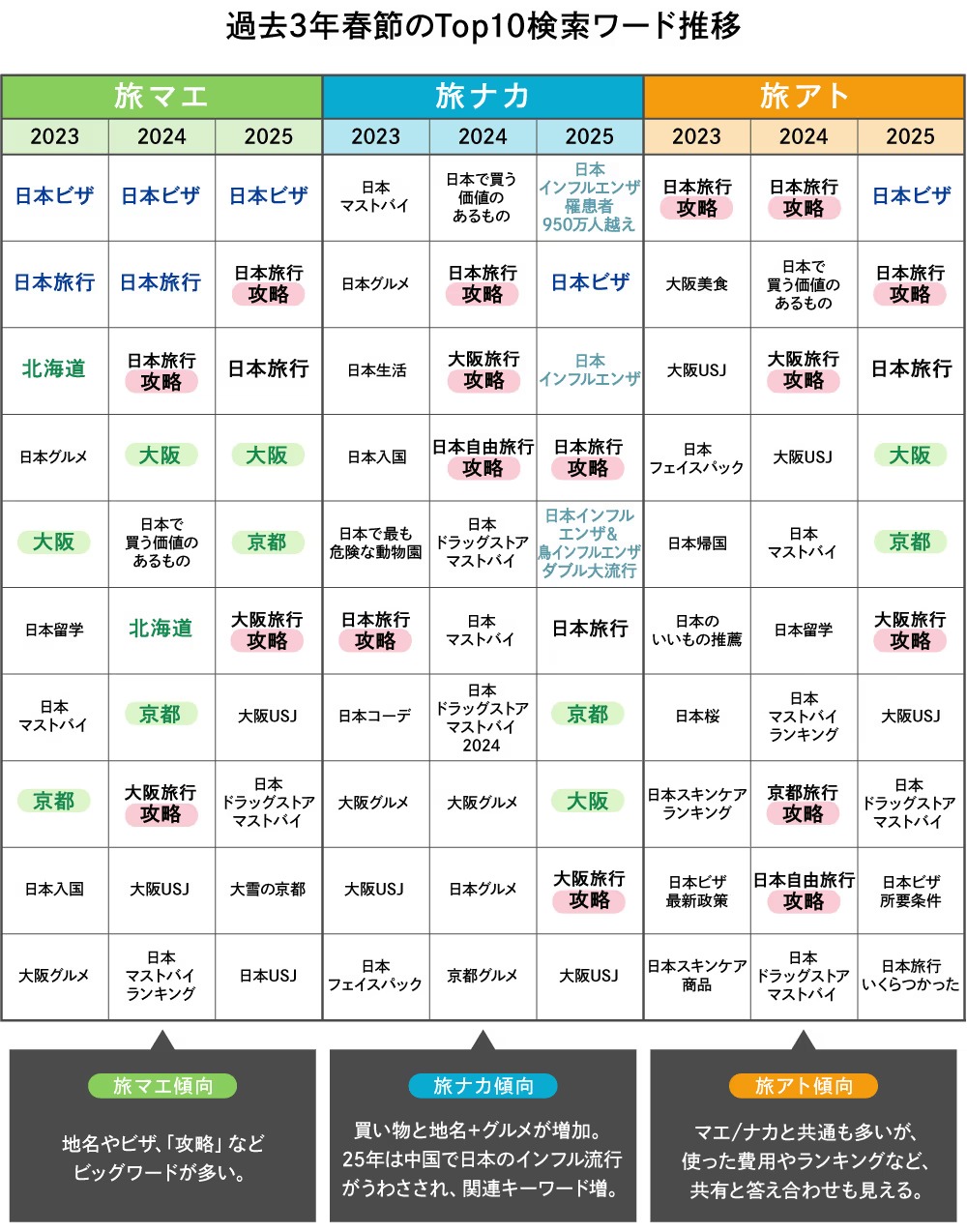
During the "pre-trip" phase when travel preparations begin, visa procedures—essential for Chinese visitors entering Japan—remain consistently at the top. Additionally, broad information searches are conducted for place names like "Japan travel," "Osaka," and "Kyoto," or by adding "攻略" (a Japanese-derived word meaning 'tips' or 'guide' in Chinese travel contexts).While many Chinese travelers are repeat visitors, and it's said "it's no longer just Tokyo, Osaka, and Kyoto," these classic spots remain overwhelmingly popular overall.
After arriving in Japan, keywords related to dining and shopping surge during the "mid-trip" phase. However, the persistence of big keywords like "Japan Travel Guide" in the top rankings suggests many travelers still haven't fully finalized their plans.Regarding 2025, on February 2nd during the Spring Festival period, the highly renowned Taiwanese actress Hsu Hsi-yuan tragically passed away after contracting influenza while traveling in Japan. This led to rumors circulating on rednote suggesting "Influenza must be rampant in Japan," causing related keywords to dominate the rankings.
Regarding "post-trip," many keywords similar to those appearing in "pre-trip" and "post-trip" segments are visible. This stems less from mere browsing and more from users referencing other posts when compiling their own experience notes. Using popular posts—their photos, text, and hashtags—as templates to maximize visibility for their own experiences is a universal trait. Naturally, this includes people already gathering information for their next trip to Japan.

So what are the characteristics and desires of people actually visiting Japan? Further analysis by behavior and destination revealed four distinct personas: "Gourmet Explorers," "Shopping Spree Heirs," "Anime Pilgrims," and "Secret Spot Travelers."Although female users predominate, with over 300 million monthly active users on rednote, men constitute about a quarter of the total. To identify male characteristics, we isolated and analyzed them as a separate segment.
Young Chinese foodies are flooding in, Osaka lives up to its reputation as the "city of gluttony," and winter staple Hokkaido is surging
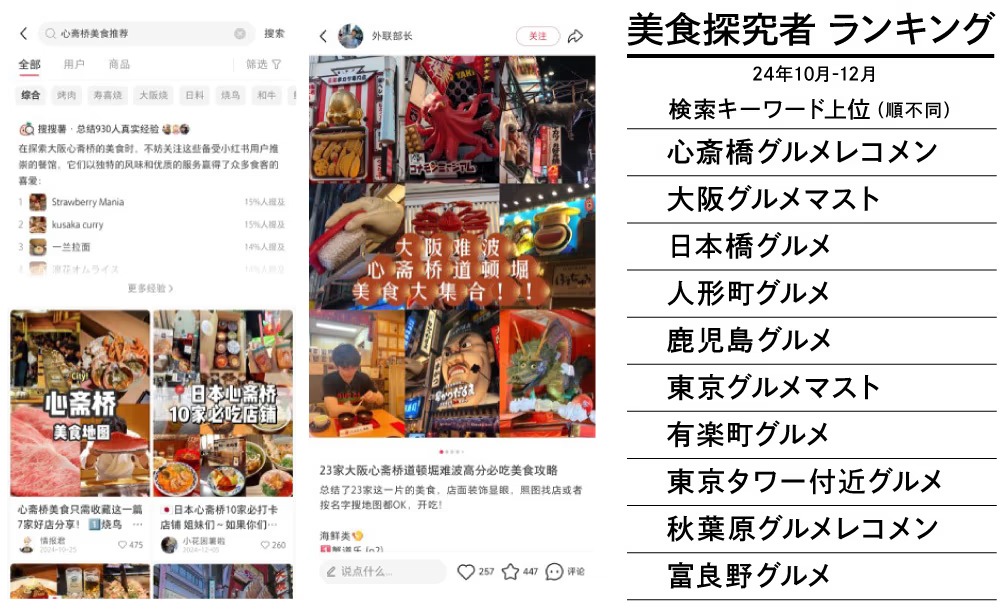
Here, we'll introduce the "Food Seekers," a segment with relatively clear characteristics. Tokyo, Kyoto, and Osaka form the so-called Golden Route of Honshu, traditionally the most popular cities among inbound tourists. Among these, Osaka-related place names dominate the top search terms, clearly attracting attention from young Chinese travelers. Specific locations like "Shinsaibashi," "Nipponbashi," "Nagahoribashi," "Daikokucho," and "Rinku Town" are frequently searched alongside these names.Conversely, names of dishes commonly considered Osaka specialties and immediately recognizable to Japanese people, like "okonomiyaki" or "takoyaki," do not appear. While takoyaki is a relatively common sight in China and carries an image of being "Japanese," it seems that among Chinese visitors to Japan, the place name "Osaka" is not as strongly associated with it as it is for Japanese people.
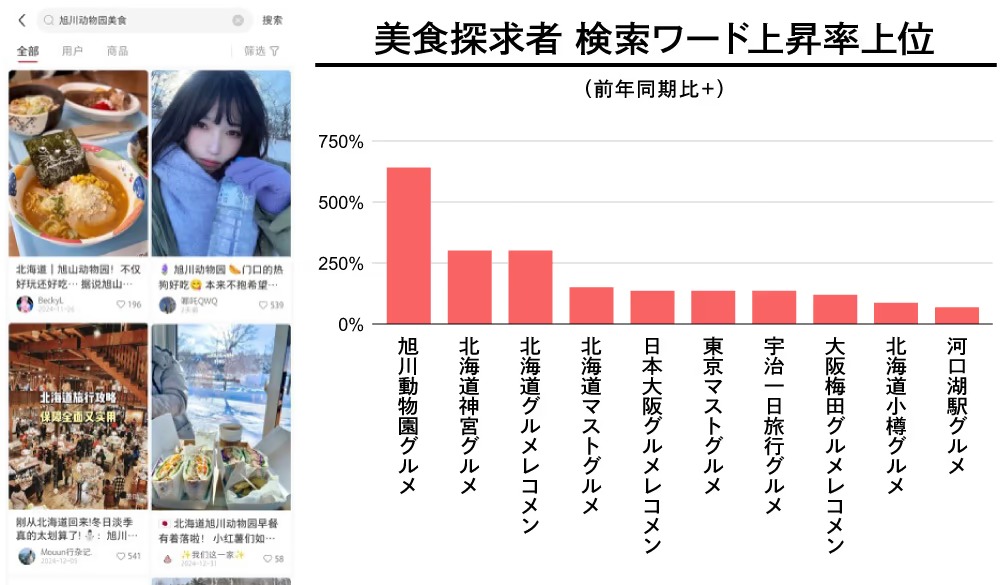
Additionally, likely influenced by the winter survey period, many trending keywords were related to Hokkaido. Interestingly, it's not the Clock Tower, typically thought of as a tourist landmark, but the Japanese-style "Hokkaido Jingu Shrine" that appears as a gourmet keyword. Furthermore, Otaru was the only Hokkaido location to rank in the TOP 10. This result suggests a broadening of destinations beyond major staples like Sapporo and Furano.
Food explorers are referencing not only major KOLs (influencers) with around 10 million followers and broad-reaching influence, but also many KOCs (Key Opinion Consumers) who, while having several thousand followers, possess high TGI(※).When a clear appeal theme is established, collaborating with KOCs—who may have smaller follower counts but wield significant influence within specific niches—for information dissemination is well worth considering for both effectiveness and efficiency.
※TGI: Abbreviation for Target Group Index. It measures the degree of deviation from the parent population of a specific segment. With 100 as the standard, a higher number indicates greater divergence from the parent population's characteristics (= possessing distinct individuality). For example, if 10% of the parent population likes apples and 20% of a certain segment likes apples, the TGI would be 200.

Within other categories too, searches occur using entirely different keywords on the same platform, and different KOLs hold influence. For instance, "2D pilgrimage enthusiasts" (anime/manga fans) search for the names of cities featured in their favorite works, while "mass-buying successors" (shopping enthusiasts) share tips on tax-free procedures.Rather than lumping all "inbound tourists" together vaguely, just as with general marketing activities targeting domestic Japan, it is difficult to achieve the desired effect without first identifying "who the potential customers are" based on available data and then formulating a strategy.
Dentsu Inc.'s Integrated Solution for Chinese Inbound Tourism
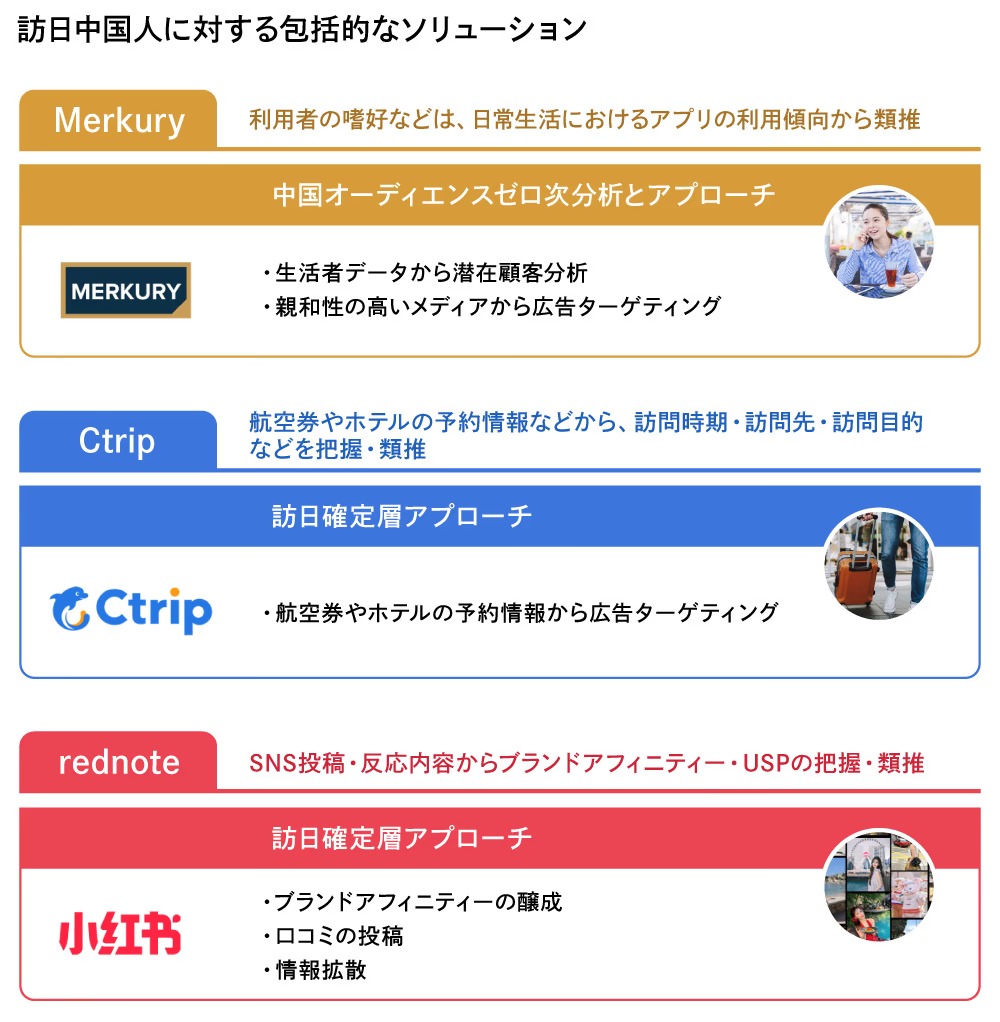
Dentsu Inc. provides a solution that comprehensively addresses marketing for visitors' "pre-trip, during-trip, and post-trip" phases.In addition to rednote, featured here, Dentsu Inc. supports clients aiming to maximize capture of inbound spending through partnerships with various tools and platforms. These include Ctrip, the largest online travel agency (OTA), and "Mercury," an audience platform leveraging Dentsu Inc. China's device information from 1.2 billion IDs. This enables effective, efficient, and pinpoint advertising targeting based on attributes and behavior.
Reference: Web Dentsu-ho News | "Understanding the Reality of Chinese Inbound Travelers in 2025 Through Data"
Additionally, rednote, newly added to this solution, maximizes cost-effectiveness by combining diverse functions under its service umbrella. This includes not only simple ad placements but also commissioning posts from influential KOLs, managing official accounts to maximize brand appeal while avoiding specific risks, and site-based e-commerce (currently primarily targeting the Chinese domestic market).Dentsu Inc. also aims to combine platform data with its own expertise, deriving and providing optimal combinations from this diverse palette.
Recommended Reading
It's Not Too Late! An Introduction to China Inbound & Cross-Border E-Commerce
The information published at this time is as follows.
Was this article helpful?
Newsletter registration is here
We select and publish important news every day
For inquiries about this article
Back Numbers
Author

Masaki Iwata
Dentsu Inc.
Global Business Center
Senior Business Development Director
Responsible for business development at Dentsu Inc.'s overseas BX/DX domain, including strategy, planning, production, and operations. Leveraging four and a half years of assignment experience in Singapore and six and a half years in Shanghai, China, I drive cross-border solutions through diverse market and cultural expertise across Japan, Southeast Asia, and mainland China.

Naoki Fujii
Dentsu Inc.
Global Business Center
Business Development Strategist
A planner pursuing the value of intangible assets from diverse perspectives including PR, advertising, and corporate ventures. Particularly adept in areas where existing knowledge and experience cannot be directly applied, such as outbound marketing from Japan and new business development. Returned to Japan in 2024 after approximately eight years living in China. Author of "New Consumption" (President Inc.) and a prolific contributor to economic media outlets.

Hiroshi Masuda
Dentsu Inc.
Global Business Center
Digital Solutions Planner
Studied in China during university. Spent a total of 10 years in China between student life and working life. After joining Dentsu Inc., was seconded to Beijing, China in 2018, where I was responsible for developing membership systems for Japanese companies and social CRM systems. After returning to Japan, I worked at GBC providing global support for companies and brands, and proposing and implementing inbound tourism initiatives for Japan.


